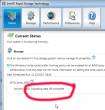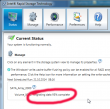Asus mobo BIOS upgrade loses Intel RAID-configuration
Monday, October 20. 2014
One of these days, I went to see if my motherboard has a newer BIOS. It had, and since I had not upgraded the BIOS after building my PC, I chose to go for upgrade.
This is one of the newer model PCs. You download the file, put it into a FAT-32 formatted USB-stick. Reboot the computer and enter UEFI-setup screens. One of them has an option to display the contents of the USB-stick and load the file, upgrade the BIOS and ... reset the settings and reboot. Wait a minute! Did I just say reset the settings. Yes.
Guess what happened to my Intel Rapid Storage Technology RAID-1 -setup. ![]()

Crapper! I didn't see that one coming. Now I remember again why I typically don't use motherboard "fake" RAIDs. Also, by the looks of it I wasn't alone with this: RAID1 changed to AHCI after BIOS update. Also, somebody with a Dell computer was experiencing something similar in the Intel's own discussion boards: Raid 1 rebuild with Rapid Storage Technology. I checked the manuals Intel® Rapid Storage Technology (Intel® RST) User guides, but didn't see anything that would help. Self-help seems always to be the best option anyway.
I turned the S-ATA mode back to RAID:
... but trying to re-create the RAID-1 volume seemed a bit dangerous:
The part where it says "Warning: All data on selected disks will be lost" kind of gets my attention. I didn't want to go that way.
Booting to Windows worked. Looks like drive(s) don't have any headers and if necessary, can act as a single drive:
Naturally when Windows sees two drives instead of one, it means that there is no RAID. To get this one fixed I started Interl Rapid Storage Technology user interface. It has the option to create RAID volume on RAID-ready drives:![]()
More importantly, it has the possibility of not erasing data on a single disc:
![]()
When accepted, the rebuild process starts. It will migrate data for hours:

When it finishes, there will be only one drive left:

As the end result, the BIOS was upgraded, RAID-1 was rebuilt and I was happy again. All it took was 6 hours of rebuild time and a lot of stress! ![]()


Tomasz on :
It was such a relief to figure out that there is a safe way to make it work again, without losing data. I my case OS was on separate SSD drive, RAID1 was made for user data (2xHDD).
For those with with fresh experience: both former RAID1 members are seen in Windows as regular drives (full access to content), as long as no attempt is made to recreate array in legacy mode (from BIOS). Just follow the procedure as described by Jari ... and you will get safe at home. No stress.